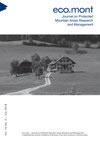奥地利的自然公园运动——从休闲区到可持续发展的示范区
IF 0.8
4区 环境科学与生态学
Q4 BIODIVERSITY CONSERVATION
Eco Mont-Journal on Protected Mountain Areas Research
Pub Date : 2020-01-01
DOI:10.1553/eco.mont-12-1s64
引用次数: 1
摘要
在奥地利,自然公园(NaP)是最古老的大型保护区。第一个nap被创建为维也纳城市人口的休闲区,并鼓励农村文化景观的经济增长。在第一批特色景观被指定为在不妨碍其经济发展的情况下保护其独特性的二十年后,成立了工作组,集中精力进一步发展和建立nap。随着奥地利国家行动计划协会这一伞形组织的成立,制定并实施了奥地利所有国家行动计划的共同战略。今天,国家行动计划的战略是同时保护自然和文化景观,并成为可持续发展的示范区域。本文重点介绍了奥地利国家公园从城市人口休闲公园到可持续发展示范区的发展历程。在奥地利建立自然公园(nap)的想法几乎与德国这一想法的出现同步。1956年,NaP协会主席Alfred Toepfer博士在协会年会上提出了在德国建立25个NaP的计划(Liesen et al 2008), 1959年,一位奥地利地理学家在Toepfer的想法的基础上,提出了在奥地利建立12个NaP的计划(Strzygowskin 1959)。仅仅过了几年,1962年,第一个国家自然保护区成立,直到2012年,一系列自然公园基金会相继成立(见表1):20世纪60年代,国家自然保护区在下奥地利州首次成立。在20世纪70年代,下奥地利州指定了9个nap,这些nap被认为是用于娱乐目的的培育自然(Schweiger 1980)。20世纪80年代,施蒂里亚划定了具有独特景观的大片地区。在20世纪90年代,上奥地利州的第一个NaP成立,以保持该地区特殊文化景观的小规模结构(Bauernfeind 1996)。还在布尔根兰与匈牙利建立了两个跨界国家行动计划。2000年至2012年期间,创建了19个NaP,总面积近31.8万公顷(Verband der naturpark Österreichs 2019a),最后一个NaP是Attersee-Traunsee;然而,早在1967年(Fossel & Probst 1988),这个领域的NaP的想法就已经被考虑过了。自2012年以来,没有再指定新的NaP。今天,nap几乎覆盖了奥地利总面积的6%。它们大小不一,涵盖了最多样化的文化景观类型。最小的NaP是下奥地利州的Falkenstein-Schwarzau / Gebirge NaP,面积为17公顷;最大的是蒂罗尔的NaP Karwendel,面积为72 741公顷。随着时间的推移,目标和功能的发展对于德国来说,从一开始就关注保护,Weber和Weber(2015)描述了nap目标和功能随着时间的发展的五个阶段。在奥地利可以确定的四个阶段,最初的目的是为城市人口创造休闲区,与这些略有不同。然而,这两个国家的主要长期目标是使国家行动计划成为可持续发展的模范区域(表2)。本文章由计算机程序翻译,如有差异,请以英文原文为准。
The Nature Park movement in Austria – from recreational areas to(wards) model regions for sustainable development
In Austria, Nature Parks (NaP) are the oldest large protected areas. The first NaPs were created both as recreational areas for the urban population of Vienna, and to encourage economic growth in rural cultural landscapes. Twenty years after the first characteristic landscapes were designated to protect their uniqueness without preventing their economic development, working groups were established to concentrate on the further development and establishment of NaPs. With the foundation of the Association of Austrian NaPs, an umbrella organization, a common strategy for all Austrian NaPs was developed and implemented. Today, the strategy of NaPs is to simultaneously protect natural and cultural landscapes and to become model regions for sustainable development. This article highlights the development of NaPs in Austria from recreational parks for the urban population to model regions for sustainable development. Foundation of Nature Parks The idea of the establisment of Nature Parks (NaPs) in Austria ran almost parallel to the emergence of the idea in Germany. In 1956, Dr. Alfred Toepfer, chairman of the NaP Association, had proposed a programme of twenty-five NaPs in Germany at the association’s annual meeting (Liesen et al 2008) and in 1959 an Austrian geographer, building on Toepfer’s idea, proposed twelve NaPs in Austria (Strzygowskin 1959). Only a few years later, in 1962, the first NaP was founded leading to a series of nature park foundations until 2012 (see Table 1): In the 1960s, first establishment of NaPs in Lower Austria. In the 1970s, nine NaPs were designated in Lower Austria which were regarded as cultivated nature for recreation purposes (Schweiger 1980). In the 1980s, large areas with distinctive landscapes were designated in Styria. In the 1990s, the first NaP in Upper Austria was founded to maintain the small-scale structure of the area’s particular cultural landscape (Bauernfeind 1996). Two cross-border NaPs were also established with Hungary, in Burgenland. Between 2000 and 2012, 19 NaPs were created, amounting to almost 318 000 ha (Verband der Naturparke Österreichs 2019a), the last one being NaP Attersee-Traunsee; yet the idea for a NaP in this area was already being considered in 1967 (Fossel & Probst 1988). No further NaP has been designated since 2012. Today, NaPs cover almost 6% of the total area of Austria. They differ in size and cover the most diverse cultural landscape types. The smallest NaP is NaP Falkenstein-Schwarzau / Gebirge in Lower Austria, with 17 ha; the largest is NaP Karwendel in Tyrol, with 72 741 ha. The development of the objectives and functions through time For Germany, where the focus from the beginning was on conservation, Weber & Weber (2015) describe five phases in the development of the objectives and functions of NaPs through time. The four phases that can be identified in Austria, where the original purpose was to create recreational areas for the urban population, differ slightly from these. Yet the main long-term aim in both countries is for NaPs to become model regions for sustainable development (Table 2).
求助全文
通过发布文献求助,成功后即可免费获取论文全文。
去求助
来源期刊

Eco Mont-Journal on Protected Mountain Areas Research
BIODIVERSITY CONSERVATION-ECOLOGY
CiteScore
1.20
自引率
0.00%
发文量
1
审稿时长
>12 weeks
期刊介绍:
eco.mont offers a platform specifically for scientists and practitioners working in and on protected mountain areas in Europe and overseas.Target audiences of the journal are scientists from all related disciplines, managers of protected areas and an interested public including practitioners, visitors, teachers, etc.
 求助内容:
求助内容: 应助结果提醒方式:
应助结果提醒方式:


